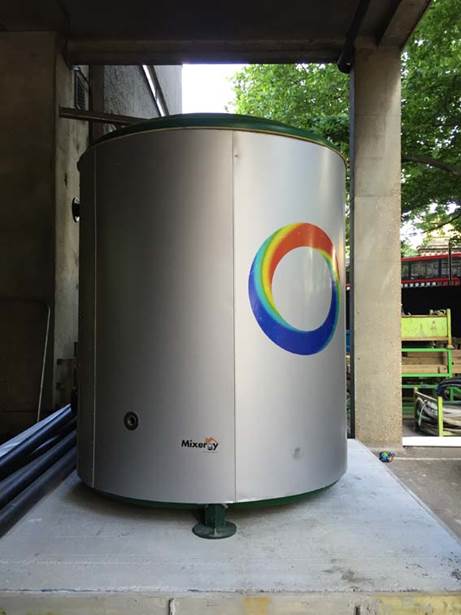Balanced Energy Networks
Distributed Heat Storage
Insulated Thermal Energy Storage
With the move to the electrification of heat and combustion-free heating it is useful to have insulated heat storage capacity to be in a position to benefit from Demand Side Response.
Insulated Thermal Energy Storage enables heat to be generated at times when power is cheaper and increases the capacity to meet peak demand.
Insulated hot water tanks with innovative stratified inlet systems can be combined with heat transfer and demand side response to provide smart hot water storage.
The tank shown on the right at London South Bank University stores 10,000 litres of hot water.
Mixergy
Mixergy Ltd, a BEN Consortium partner, has worked with ICAX on the original Balanced Energy Network at London South Bank University to provide very large heavily insulated tanks to store hot water with minimal heat losses and bridge the gap between times of cheaper electric supply (often at night) and demand for hot water by day.
Demand Side Response
In order to take advantage of Demand Side Response it is necessary for Mixergy tanks to use electric heating and have a control system linked in to an electricity aggregator who is able to provide a lower cost of electricity if the heating system is tuned to respond to price signals from the Grid. The most efficient mechanism for electric heating is provided by heat pumps. However, when the Grid has surplus electricity it can be appropriate to use direct electric heating in thermal heat stores.
Upside Energy, a BEN Consortium partner, worked with Mixergy on the original Balanced Energy Network at London South Bank University in order to embed the communications links from Mixergy controls systems for heat stores to the Upside Cloud systems to enable LSBU to take advantage of Demand Side Response.
Smart Hot Water Storage
Mixergy insulated tanks with innovative stratified inlet systems can be combined with demand side response to provide smart hot water storage: Thermal Energy Storage.
See video on Balancing supply and demand for electricity.




